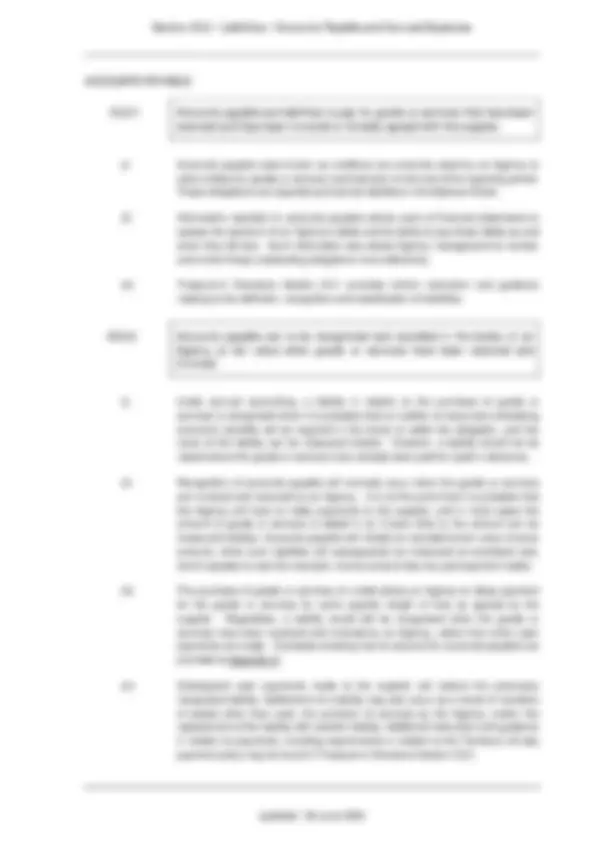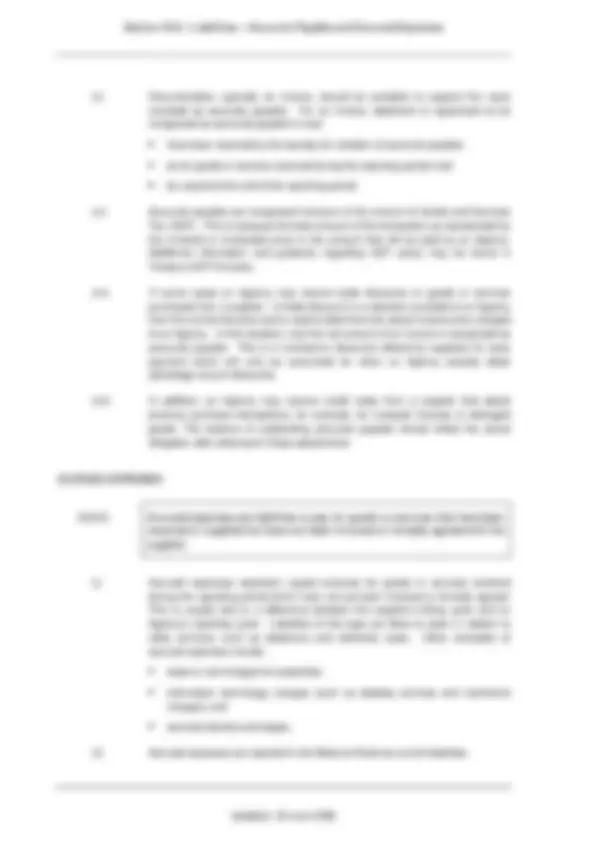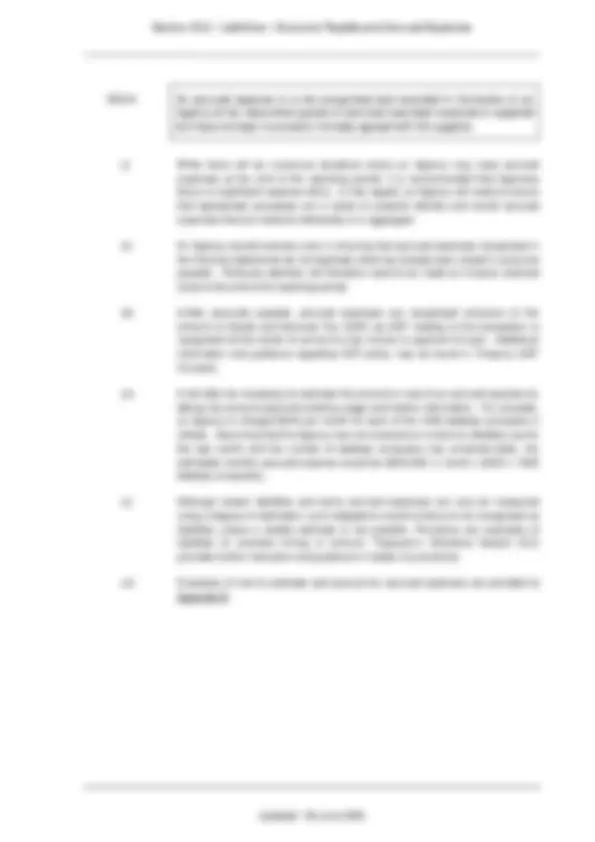






Study with the several resources on Docsity

Earn points by helping other students or get them with a premium plan


Prepare for your exams
Study with the several resources on Docsity

Earn points to download
Earn points by helping other students or get them with a premium plan
Community
Ask the community for help and clear up your study doubts
Discover the best universities in your country according to Docsity users
Free resources
Download our free guides on studying techniques, anxiety management strategies, and thesis advice from Docsity tutors
An overview of accounting for accounts payable and accrued expenses, including definitions, recognition, and recording procedures. It also includes examples and references to related treasurer's directions and accounting standards. Understanding these concepts is essential for preparing accurate financial statements.
Typology: Study notes
1 / 8

This page cannot be seen from the preview
Don't miss anything!





Complete and accurate information on accounts payable and accrued expenses enables users of financial statements to assess an Agency’s ability to pay its debts when they fall due. This Section explains the concepts and requirements in relation to accounts payable and accrued expenses.
Section 38 of the Financial Management Act requires every Accountable Officer and every employee of an Agency to comply with the Treasurer’s Directions.
Accounts Payable
Accrued Expenses
For authoritative instruction and guidance, reference should be made to related Treasurer's Directions and associated commentary, relevant Australian accounting standards and other authoritative interpretations.
Accounts Payable
Accrued Expenses
Appendix A Accounting for Accounts Payable – Examples
Appendix B Accounting for Accrued Expenses – Examples
Financial Management Act
AAS 29 Financial Reporting by Government Departments
AASB 132 Financial Instruments: Disclosure and Presentation
AASB 137 Provisions, Contingent Liabilities and Contingent Assets
AASB 139 Financial Instruments: Recognition and Measurement
Related Treasurer’s Directions:
. (^) A3.1 Accounting – Liabilities : Overview
A3.3 Accounting – Liabilities : Provisions
C3.2 Cash Management – Transaction Management : Payments
(v) Documentation, typically an invoice, should be available to support the value recorded as accounts payable. For an invoice, statement or agreement to be recognised as accounts payable it must:
(vi) Accounts payable are recognised inclusive of the amount of Goods and Services Tax (GST). This is because the total amount of the transaction as represented by the invoiced or contracted price is the amount that will be paid by an Agency. Additional information and guidance regarding GST policy may be found in Treasury GST Circulars.
(vii) In some cases an Agency may receive trade discounts on goods or services purchased from a supplier. A trade discount is a reduction provided to an Agency from the normal list price and is used to determine the actual invoice price charged to an Agency. In this situation, only the net amount of an invoice is recognised as accounts payable. This is in contrast to discounts offered by suppliers for early payment which will only be accounted for when an Agency actually takes advantage of such discounts.
(viii) In addition, an Agency may receive credit notes from a supplier that adjust previous purchase transactions, for example, for overpaid invoices or damaged goods. The balance of outstanding accounts payable should reflect the actual obligation after allowing for these adjustments.
A3.2.3 Accrued expenses are liabilities to pay for goods or services that have been received or supplied but have not been invoiced or formally agreed with the supplier.
(i) Accrued expenses represent unpaid amounts for goods or services received during the reporting period which have not yet been invoiced or formally agreed. This is usually due to a difference between the supplier’s billing cycle and an Agency’s reporting cycle. Liabilities of this type are likely to arise in relation to utility services, such as telephone and electricity costs. Other examples of accrued expenses include:
(ii) Accrued expenses are reported in the Balance Sheet as current liabilities.
A3.2.4 An accrued expense is to be recognised and recorded in the books of an Agency at fair value when goods or services have been received or supplied but have not been invoiced or formally agreed with the supplier.
(i) While there will be numerous situations where an Agency may raise accrued expenses at the end of the reporting period, it is recommended that Agencies focus on significant expense items. In this regard, an Agency will need to ensure that appropriate processes are in place to properly identify and record accrued expenses that are material individually or in aggregate.
(ii) An Agency should exercise care in ensuring that accrued expenses recognised in the financial statements do not duplicate what has already been raised in accounts payable. Particular attention will therefore need to be made to invoices received close to the end of the reporting period.
(iii) Unlike accounts payable, accrued expenses are recognised exclusive of the amount of Goods and Services Tax (GST) as GST relating to the transaction is recognised at the earlier of arrival of a tax invoice or payment of cash. Additional information and guidance regarding GST policy may be found in Treasury GST Circulars.
(iv) It will often be necessary to estimate the amount or cost of an accrued expense by taking into account past and existing usage and historic information. For example, an Agency is charged $240 per month for each of the 1000 desktop computers it utilises. Assuming that the Agency has not received an invoice for desktop use for the last month and the number of desktop computers has remained static, the estimated monthly accrued expense would be $240,000 (1 month x $240 x 1000 desktop computers).
(v) Although certain liabilities and some accrued expenses can only be measured using a degree of estimation, such obligations would continue to be recognised as liabilities unless a reliable estimate is not possible. Provisions are examples of liabilities of uncertain timing or amount. Treasurer’s Directions Section A3. provides further instruction and guidance in relation to provisions.
(vi) Examples of how to estimate and account for accrued expenses are provided at Appendix B.
Example 1 – Accrued Telephone Expenses
An Agency is billed for telephone usage on the 15 th^ day of each month. The invoice for telephone services for the period from 15 June to 14 July is due on 15 July. At the end of June telephone expenses relating to the period from 15 June to 30 June will need to be estimated and recorded in the accounts as accrued expenses.
Review of previous monthly invoices provides an average monthly bill of $60,000 (excluding GST).
Estimated telephone expense for a month $60,
Estimated telephone expense from 15 - 30 June = $60,000 x 16 days/30 days
Accrued Telephone Expenses = $32,
On 30 June the following journal entry would be processed:
DR Telecommunications Expense
(Increase in Expenses – Operating Statement)
CR Accrued Expenses (Increase in Liabilities – Balance Sheet) $32,
Where the above journal is not reversed in the next reporting period, the following journal entry would be processed on receipt of an invoice for $44,000 (including $4,000 GST):
DR Telecommunications Expense
(Increase in Expenses – Operating Statement)
DR GST Owing/Paid (Increase in Assets – Balance Sheet) $4,
DR Accrued Expenses (Decrease in Liabilities – Balance Sheet) $32,
CR Accounts Payable (Increase in Liabilities – Balance Sheet) $44,
On payment, the journal entry would be:
DR Accounts Payable (Decrease in Liabilities – Balance Sheet) $44,
CR Cash at Bank (Decrease in Assets – Balance Sheet) $44,
APPENDIX B (continued)
Example 2 – Accrued Electricity Expenses
An Agency has incurred costs for electricity usage prior to 30 June but has not yet received an invoice for these electricity costs. Journal entries are required to recognise an expense and a liability to reflect electricity usage for the period from the last billing date up to reporting date (in this case 30 June). The amount recorded would be an estimate that could be based on prior usage patterns. If the Agency’s previous electricity bill for a 3 month period was $30,000 (excluding GST) and 2 months have elapsed since the last bill, the following journal entry would be processed:
DR Power Expense (Increase in Expenses – Operating Statement) $20,
CR Accrued Expense (Increase in Liabilities – Balance Sheet) $20,
Where the above journal is not reversed in the next period, the following journal entry would be processed on receipt of an invoice for $44,000 (including $4,000 GST) for 3 months of electricity use:
DR Power Expense (Increase in Expenses – Operating Statement) $20,
DR GST Owing/Paid (Increase in Assets – Balance Sheet) $4,
DR Accrued Expense (Decrease in Liabilities – Balance Sheet) $20,
CR Accounts Payable (Increase in Liabilities – Balance Sheet) $44,
On payment, the journal entry would be:
DR Accounts Payable (Decrease in Liabilities – Balance Sheet) $44,
CR Cash at Bank (Decrease in Assets – Balance Sheet) $44,